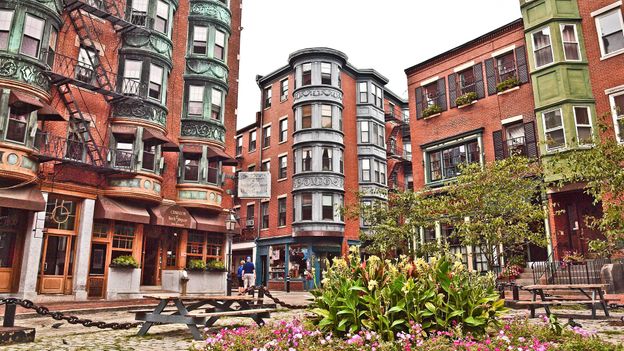A small peninsula jutting into the Boston Harbor, the North End is one of the city’s oldest and most storied neighbourhoods. Puritans from England settled the area, followed by waves of other European immigrants whose red-brick homes still crowd the narrow, maze-like streets. By the early 20th Century, tens of thousands of Italian immigrants had transformed this 1-sq-km area into the city’s “Little Italy” (although nobody calls it that!).
Today, the North End retains its multicultural atmosphere. The streets are lined with Italian restaurants and delis, and you can still overhear animated Italian conversations on the street. “It’s the greatest inner-city Italian community in the United States,” exclaimed resident Frank Depasquale. “It’s one of a kind.”
Like many immigrants before him, Depasquale settled in the North End when his family arrived from Italy some 67 years ago. He opened a small shop called Il Panino, where he hawked sandwiches made with homemade bread, Parma prosciutto and buffalo mozzarella. Today, he owns and operates nine Italian food enterprises in the North End, and you can still get his signature “Panino” sandwich at his shop, Bricco Salumeria .
“The way to experience this neighbourhood is to come here with an open mind,” Depasquale said. When you see someone speaking Italian, say a couple of words back to them. They would love to tell you directions to where you want to go… that’s how this whole neighbourhood is constructed. We hug people. We give them double kisses. We give them directions and we help them with anything they need.”
Here are Depasquale’s five recommendations of what travellers shouldn’t miss when they come to the North End.
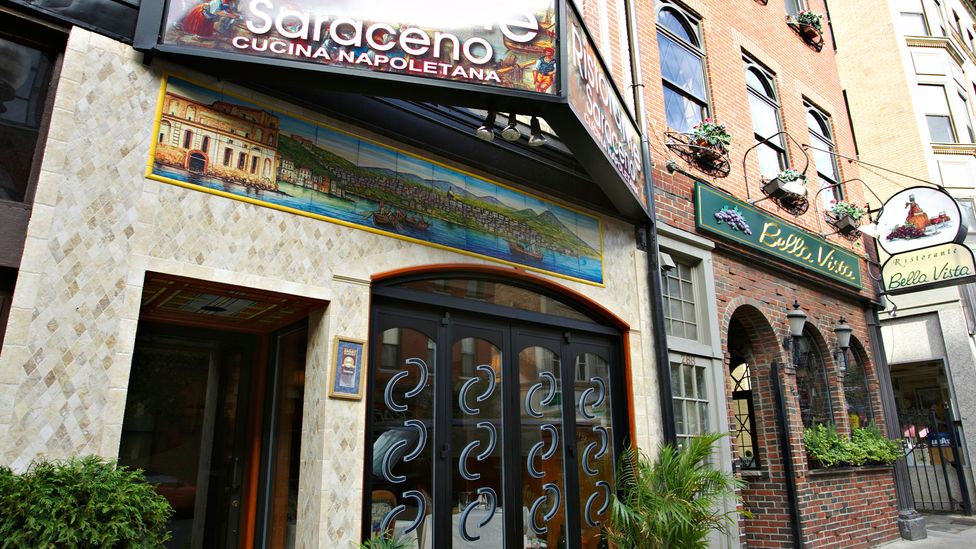
Every region of Italy is represented by the restaurants in Boston’s North End (Credit: Kim Karpeles/Alamy)
1. Indulge in Italian cuisine
With nearly 100 restaurants, delis and cafes packed into the neighbourhood, sampling the restaurant scene is one of the best ways to experience the rich Italian-American heritage of the North End, says Depasquale. Every region of Italy is represented, and restaurants cater to all price ranges, from a $3.25 slice of Sicilian pizza at Galleria Umberto to the elaborate tableside presentation of Roman caccio e pepe at Nico Ristorante . Some of Depasquale’s favourites include Forcella , a romantic restaurant located on North Square; Carmelina’s , with incredible pasta dishes coming out of the open kitchen; and Saraceno , serving classic Neapolitan fare.
Elsewhere, Depasquale’s original restaurant, now known as Trattoria Il Panino , offers fine dining, with handmade pasta and fresh shellfish, reminiscent of the cuisine on the Amalfi coast. A newer venture, Quattro serves Neapolitan pizzas in a more casual setting. Depasquale is quick to point out that “you can’t really make a mistake at any restaurant in the North End”, acknowledging that diners are spoiled for choice.
“The competition is so great… we all borrow from each other.” he added. “When we run out of a certain wine or olive oil or bread… we all work hand in hand to make sure. Because if one person fails, we all fail.”
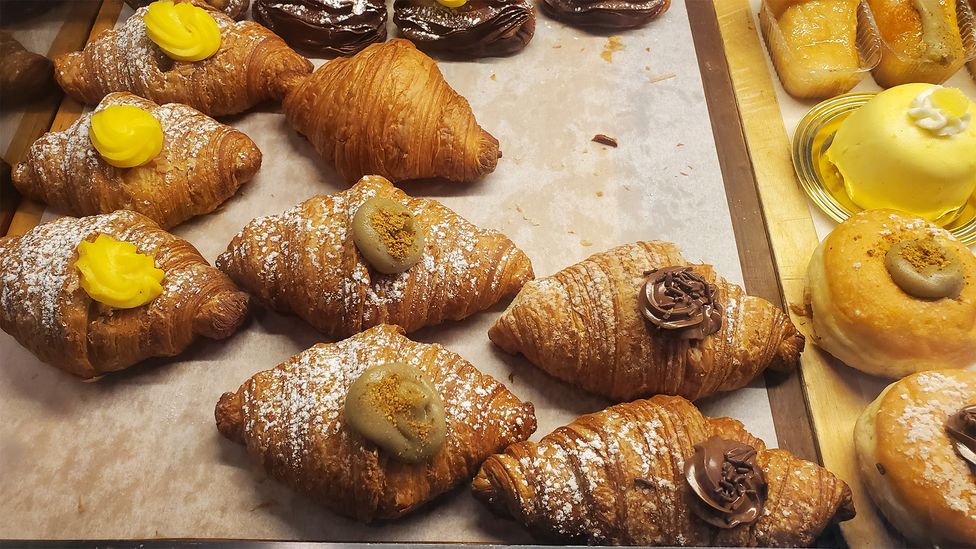
Hanover Street is home to some of the North End’s best Italian cafes (Credit: Mara Vorhees)
2. Experience cafe culture
One unique aspect of dining in the North End, says Depasquale, is that “you don’t just leave the restaurant and go home. You go to the cafes afterwards”, whether for a digestive or for dessert or just to chat.
Italian cafes are an essential part of the North End experience. A visitor might stop their sightseeing for a mid-afternoon espresso, cool off with a gelato or sample some of the irresistible Italian pastries that are available at any of the cafes on Hanover Street. Cannoli are the most famous, but Depasquale also recommends rum babà (rum cake) or sfogliatelle (flaky layered pastries with ricotta filling). His personal favourite is the delizia al limone , a sponge cake filled with lemon custard, which is a specialty from the Amalfi Coast.
Depasquale says that many cafes on this stretch of Hanover Street have their own appeal. Caffè Paradiso is a favourite among locals to sip amaro and shoot the breeze. Down the street, Caffè Vittoria has been serving cappuccino and cannoli for nearly a century, making it the oldest Italian cafe in the city (with a collection of vintage coffee makers to prove it). And next door is Caffè dello Sport whose walls are adorned with portraits of Italian sports stars.
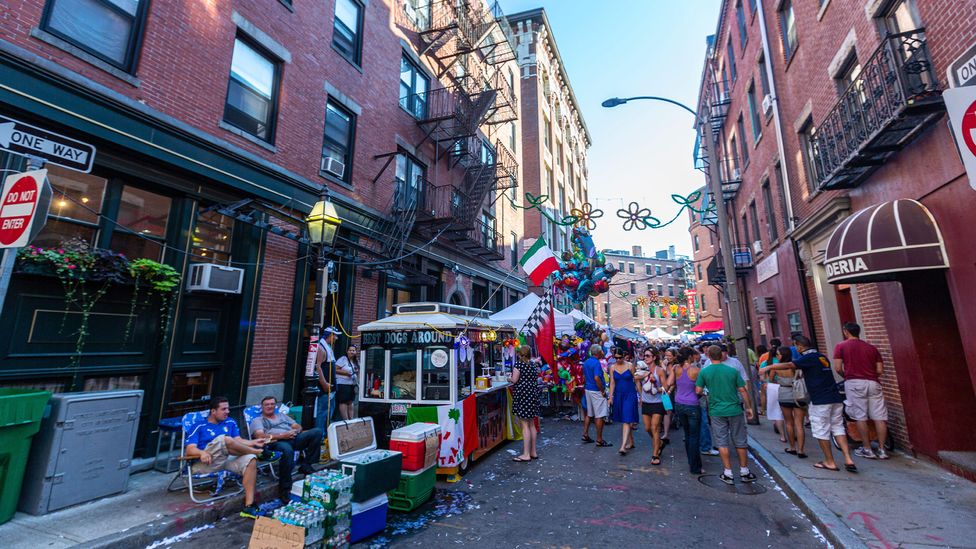
Attending a summer Italian Feast is a quintessential North End experience (Credit: Jorge Tutor/Alamy)
3. Attend an Italian feast
Every summer, the North End’s religious fervour and community spirit are on full display at the neighbourhood’s Italian Feasts , each celebrating a different Catholic saint. Depasquale asserts that these feasts are the quintessential North End experience, bringing together food, faith and fun in a festive community tradition.
North End practical tips
• Make dinner reservations in advance, especially from May to October and weekends year-round.
• Don’t try to park in the North End! Take the T (subway) to Haymarket and stroll across the Rose Kennedy Greenway.
• If you must drive, park at the Parcel 7 Garage (near Haymarket), which is $3 for three hours with a ticket validated by a North End establishment.
Lights and banners hang across the streets, which are packed with food stalls serving Italian sausage, fried calamari and gelato, plus fairground games and live entertainment. The highlight of each festival is the Grand Procession, when believers carry a statue of the honoured saint through the crowded streets, followed by marching bands and celebratory floats.
The multi-day street festivals take place almost every weekend in August and early September. The highlight takes place the last weekend in August with St Anthony’s Feast , the largest Italian festival in New England. More than 100 food vendors set up on the back roads of the North End, hawking arancini, calzones and other Italian treats. Italian marching bands parade through the streets, welcoming all-comers to the celebration. Each evening, live bands take to the stage for sing-alongs and dancing under the stars.
For his part, Depasquale is partial to the Feast of San Gennaro, honouring the patron saint of Naples. It is one of the smaller feasts, he admits, but it is an excellent option for visitors because all of the food vendors are local. Past festivals have featured meatball sliders from Table , fresh caprese salad from Riccardo’s , fried zucchini flowers from Assaggio and desserts from Modern Pastry , among other Italian specialities.
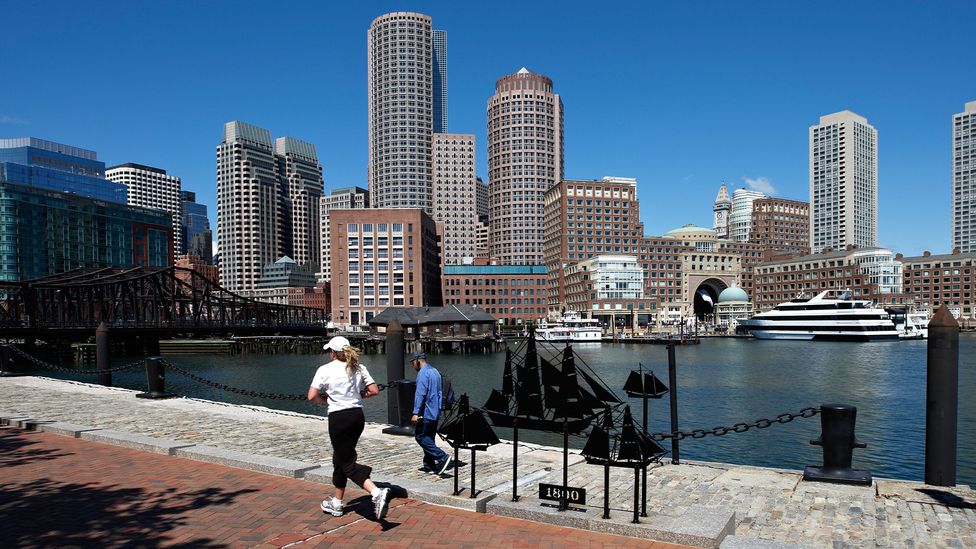
Langone Park offers sweeping views of the Boston Harbor (Credit: Hemis/Alamy)
4. Relax at Langone Park
Located at the northern tip of the North End, Langone Park is an inviting green space with expansive views to the Zakim Bridge from one end and the Boston Harbor from the other. It is, according to Depasquale, “one of the nicest things to happen to the North End”. This is where neighbourhood residents come to exercise, socialise and play. Families congregate around the athletic fields to watch children’s soccer matches and baseball games. The old-timers play bocce and converse in Italian. “And on a hot summer day,” Depasquale said, “you’ll see half the population of the North End in the swimming pool.”
Today’s vibrant park scene belies the sordid history of this site. It used to contain storage tanks for molasses, which was shipped in from the Caribbean for the production of rum and munitions. In January 1919, one of these massive tanks ruptured, sending 2.3 million gallons of sticky molasses gushing into the crowded streets of the North End. The huge wave of goo destroyed everything in its path, including the fire station and the elevated train tracks. Twenty-one people died, while hundreds more were injured in this strange and tragic incident. The only physical remembrance from the so-called Great Molasses Flood is a small plaque in Langone Park, near where the tank once stood.
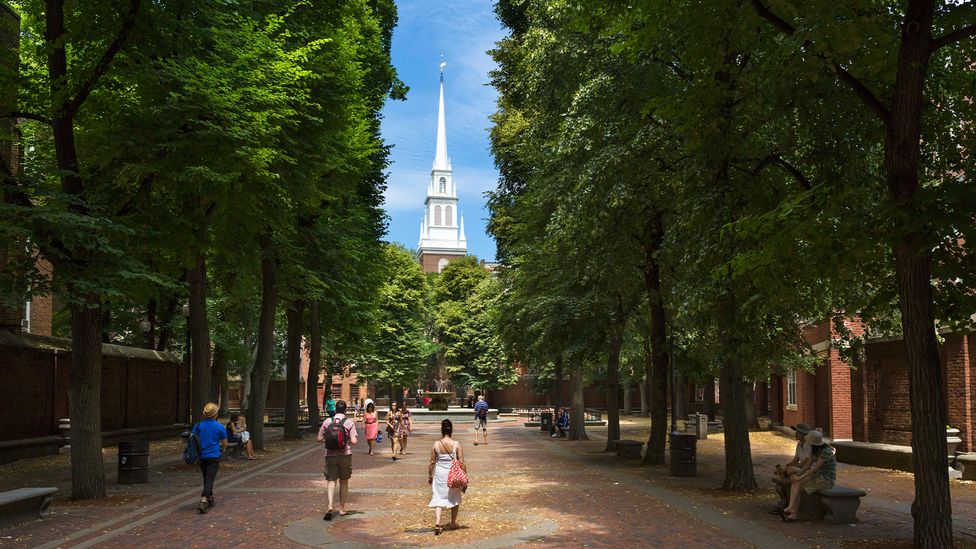
The Freedom Trail winds through the North End and through the leafy Paul Revere Mall (Credit: Ian Dagnall/Alamy)
5. Walk the Freedom Trail
Inhabited since 1630, the North End was a vibrant residential community long before Italian immigrants began arriving on these shores, and from Puritan settlers to waves of African American, Irish and Eastern European residents, it’s certainly seen a lot of history in the last four centuries. As Depasquale noted, “This is where people come to study the history of the United States”, and following the 2.5-mile long Freedom Trail that connects 17 historic sites from Downtown Boston to the North End is a great way to do that.
There are three Freedom Trail stops in the North End intricately related to US independence. The Paul Revere House was the famous US patriot’s home. A short walk away at the Old North Church , on that fateful night in 1775 when Revere rode to Lexington to warn his fellow Patriots that British soliders were coming to arrest them, the sexton hung two lanterns to signal the movement of British troops. And nearby Copp’s Hill Burying Ground contains graves of patriot sympathisers (whose headstones were purportedly used for target practice by British troops). Tourists and students of history can follow the red-brick trail that winds through the North End streets and across the shady Paul Revere Mall .
“Tourists come from all over the world to see the historic sites,” Depasquale said. “It’s a great way to spend a day. Have a quick lunch in the North End, walk around, have an espresso or cappuccino, then maybe stay in the neighbourhood because it would be a sin to miss dinner.”

